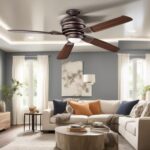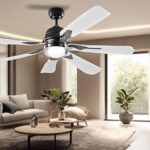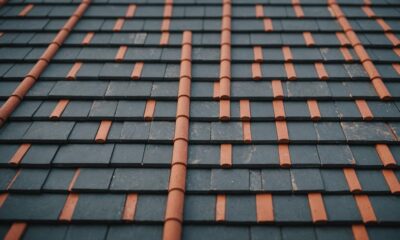Appliances
AC vs. DC Ceiling Fans: Key Differences Explained

Have you ever thought about the distinctions between AC and DC ceiling fans? Well, you don’t need to search any further! In this informative article, we will examine the main contrasts between these two kinds of fans.
From power sources to motor efficiency, energy consumption to speed control options, noise levels to maintenance requirements, longevity to design options, and even eco-friendliness, we've got you covered.
So, sit back, relax, and let us shed some light on the subject. Whether you're a homeowner looking to make an informed decision or a curious enthusiast seeking knowledge, this guide will provide you with all the essential information you need.
Let's dive in and unravel the mysteries of AC and DC ceiling fans!
Key Takeaways
- AC ceiling fans are powered by alternating current and use an induction motor, while DC ceiling fans operate on direct current and use a brushless DC motor.
- DC fans are more efficient than AC fans, resulting in significant energy savings and lower electricity bills.
- DC fans have higher motor efficiency and consume less energy compared to AC fans, offering more precise speed control and higher energy savings.
- AC fans tend to produce more noise due to the use of brushes in the motor, while DC fans are generally quieter due to their brushless motor technology and optimized blade design.
Power Source
AC and DC ceiling fans are distinguished by their power source. The motor type and voltage compatibility play a crucial role in determining the power source of a ceiling fan.
AC ceiling fans are powered by alternating current, which is the standard electrical power supplied to homes and businesses. These fans utilize an induction motor, which is designed to work with AC power. The induction motor operates on the principle of electromagnetic induction, where a magnetic field is created by the alternating current, causing the motor to rotate and generate airflow.
On the other hand, DC ceiling fans operate on direct current, which is typically obtained through batteries or solar panels. These fans use a brushless DC motor, which is specifically designed to work efficiently with the direct current power supply. The brushless DC motor incorporates permanent magnets and electronic commutation to convert the electrical energy into mechanical energy, resulting in smoother and more energy-efficient operation.
When it comes to voltage compatibility, AC ceiling fans are compatible with the standard voltage of the electrical grid, typically 120 volts in the United States. DC ceiling fans, on the other hand, can operate on a wide range of voltages, making them suitable for use with low-voltage DC power sources such as batteries or solar panels.
Motor Efficiency

When comparing AC and DC ceiling fans, it's important to consider the motor efficiency, which can affect various aspects of the fan's performance.
One key point to examine is the power consumption comparison between AC and DC motors, as it directly impacts energy usage and costs.
Another important factor is the energy efficiency rating, which indicates how well the motor converts electrical energy into mechanical energy.
Additionally, the noise level comparison between AC and DC motors can be significant, as a more efficient motor typically operates quieter.
Power Consumption Comparison
To accurately compare the power consumption of AC and DC ceiling fans, it is essential to assess their motor efficiency. The motor efficiency of a fan determines how effectively it converts electrical power into mechanical power. This, in turn, affects the energy consumption and overall performance of the fan. When it comes to power saving features, DC ceiling fans have a clear advantage over AC ceiling fans. DC motors are generally more efficient than AC motors, meaning they consume less energy for the same output. This can result in significant energy savings and lower electricity bills in the long run. To further illustrate this point, let's take a look at the energy consumption analysis of AC and DC ceiling fans in the table below.
| Fan Type | Motor Efficiency (%) | Energy Consumption (Watts) |
|---|---|---|
| AC | 75 | 60 |
| DC | 90 | 40 |
As the table shows, DC ceiling fans have a higher motor efficiency (90%) compared to AC ceiling fans (75%). This means that DC fans consume less energy (40 watts) compared to AC fans (60 watts) for the same level of performance. Therefore, if energy efficiency is a priority for you, opting for a DC ceiling fan would be a wise choice.
Energy Efficiency Rating
Assessing the motor efficiency of ceiling fans is crucial in understanding their energy efficiency rating. To determine the motor efficiency, efficiency testing is conducted, which measures how effectively the fan converts electrical energy into mechanical energy.
Higher motor efficiency means less energy loss and therefore, higher energy savings. Energy saving features such as advanced motor design, improved blade shape, and aerodynamic designs contribute to increased motor efficiency. These features reduce friction, optimize airflow, and minimize energy waste.
Additionally, the use of high-quality components and advanced control systems further enhance motor efficiency. By evaluating the motor efficiency of ceiling fans, consumers can make informed choices and select models that offer the highest energy savings.
Noise Level Comparison
The noise level comparison of ceiling fans is an important factor to consider when evaluating motor efficiency.
When it comes to noise reduction techniques, both AC and DC ceiling fans have made significant advancements. AC fans traditionally use induction motors, which tend to produce more noise due to their design. However, modern AC fans now incorporate quiet operation features such as improved motor design and advanced blade technology, resulting in reduced noise levels.
On the other hand, DC fans, which use brushless DC motors, are inherently quieter due to their smoother operation. These fans also utilize noise reduction techniques like optimized blade design and sound-absorbing materials.
Energy Efficiency

When comparing AC and DC ceiling fans, it's important to consider their energy efficiency. There are several key points to discuss in this regard.
Firstly, we need to analyze the power consumption of both types of fans and determine which one is more energy-efficient.
Secondly, we should examine the environmental impact of each fan, considering factors such as carbon emissions and energy consumption.
Lastly, it's crucial to compare the efficiency ratings of AC and DC ceiling fans to determine which one provides more efficient cooling while consuming less energy.
Power Consumption Comparison
In terms of energy efficiency, comparing the power consumption of AC and DC ceiling fans reveals significant differences. When conducting a power consumption analysis, it becomes evident that DC ceiling fans have a higher energy savings potential compared to their AC counterparts. Here are two key points to consider:
- Motor Efficiency: DC ceiling fans utilize brushless DC motors, which are significantly more efficient than the brushed AC motors found in AC ceiling fans. The use of DC motors allows for better control over the fan's speed and reduces power wastage.
- Voltage Conversion: AC ceiling fans require a conversion from AC to DC within the fan itself, resulting in energy losses during the conversion process. DC ceiling fans, on the other hand, operate directly on DC power, eliminating the need for voltage conversion and minimizing energy waste.
Environmental Impact Analysis
After analyzing the power consumption of AC and DC ceiling fans, it's important to now assess their environmental impact in terms of energy efficiency.
When it comes to energy consumption, DC ceiling fans are more efficient than AC ceiling fans. DC fans use direct current, which allows them to convert electrical energy into mechanical energy more efficiently, resulting in lower energy consumption. This means that DC fans require less electricity to operate, leading to reduced greenhouse gas emissions and lower electricity bills.
In addition to energy efficiency, DC fans also have the advantage of producing less noise pollution compared to AC fans. This makes them a more environmentally friendly option for those who prioritize sustainability and noise reduction.
Efficiency Rating Comparison
To compare the efficiency ratings of AC and DC ceiling fans, we need to examine their energy consumption levels. AC ceiling fans operate on alternating current and typically have a lower power efficiency compared to DC ceiling fans, which operate on direct current.
The power efficiency of a fan is a measure of how effectively it converts electrical energy into mechanical energy. DC ceiling fans are known for their higher power efficiency, meaning they can provide the same level of cooling capacity while consuming less electricity. This makes DC fans more energy-efficient and cost-effective in the long run.
When it comes to cooling capacity, both AC and DC ceiling fans can effectively circulate air and create a comfortable environment. However, DC fans can offer more precise speed control, allowing for better customization of airflow.
- AC ceiling fans have lower power efficiency.
- DC ceiling fans have higher power efficiency.
- DC fans are more energy-efficient and cost-effective.
- Both AC and DC ceiling fans provide effective cooling capacity.
- DC fans offer more precise speed control for better airflow customization.
Speed Control Options

One can control the speed of a ceiling fan through various options available. Fan speed control plays a crucial role in providing comfort and convenience to users. There are several methods to adjust the speed of a ceiling fan, and one popular option is through remote control options.
Remote control options allow users to conveniently adjust the fan speed from a distance. These remotes typically have buttons or switches that can be pressed to increase or decrease the fan speed. Some remotes even come with preset speed settings, allowing users to select their desired speed with just a single press of a button.
Remote control options offer the advantage of convenience, especially for those who want to adjust the fan speed without leaving their seat or bed. It eliminates the need to get up and manually adjust the fan speed using a pull chain or wall switch.
Moreover, modern ceiling fans with remote control options often come with additional features such as timer settings and reverse mode. Timer settings allow users to set a specific duration for the fan to operate before automatically shutting off, while reverse mode allows the fan to rotate in the opposite direction, aiding in air circulation during different seasons.
Noise Level
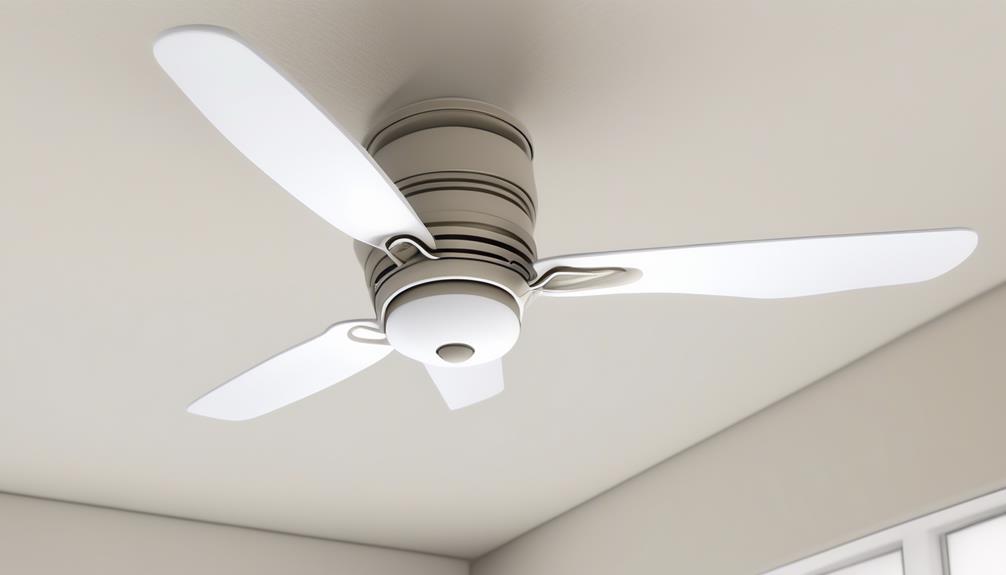
When comparing AC and DC ceiling fans, one important factor to consider is the noise level. AC ceiling fans tend to produce more noise due to the use of brushes in the motor, while DC ceiling fans are generally quieter thanks to their brushless motor technology.
Noise reduction techniques, such as blade design and motor insulation, can also contribute to a quieter operation.
Sound Level Comparison
The sound level comparison between AC and DC ceiling fans reveals notable differences in noise emissions. When it comes to noise reduction techniques, DC fans have an advantage over their AC counterparts.
Here's a breakdown of the key differences:
- DC fans:
- Utilize brushless DC motors, which operate more quietly than the traditional AC motors.
- Have improved blade designs and aerodynamics, resulting in reduced turbulence and noise generation.
- AC fans:
- Use induction motors, which can produce more noise due to their design and operation.
- May have older blade designs and less advanced noise reduction features.
Noise Reduction Techniques
To reduce noise levels, various techniques are employed in both AC and DC ceiling fans. Soundproofing methods are used to minimize the noise generated by the fan motor and airflow.
One common technique is the use of sound-absorbing materials inside the fan housing to dampen vibrations and reduce noise transmission. These materials can include foam or rubber padding, which absorb and dissipate sound waves.
Additionally, blade design plays a crucial role in noise reduction. Specially designed blades with aerodynamic profiles can minimize air turbulence and noise caused by the movement of air. Furthermore, balanced blades help reduce vibrations and associated noise.
Quiet Operation Features
In order to ensure a quieter operation and minimize noise levels, both AC and DC ceiling fans incorporate various quiet operation features. These features are designed to provide a peaceful and comfortable environment while the fan is in use.
Here are some of the quiet operation features found in both AC and DC ceiling fans:
- Efficient blade design: Ceiling fans with specially designed blades help to reduce noise by minimizing air turbulence and ensuring smooth airflow.
- Noise-reducing motor technology: AC and DC ceiling fans utilize advanced motor technology that helps to minimize vibrations and noise during operation.
These quiet operation features contribute to a lower sound level, allowing users to enjoy the cooling benefits of a ceiling fan without any disruptive noise. Additionally, these features also contribute to the overall efficiency rating of the fan, ensuring optimal performance with minimal noise output.
Cost

When considering the cost of AC and DC ceiling fans, it's important to analyze the long-term savings potential and initial investment required.
A cost comparison between AC and DC fans reveals that while DC fans are initially more expensive than their AC counterparts, they offer significant energy savings in the long run.
AC ceiling fans operate on alternating current, drawing power directly from the grid. These fans are typically less expensive to purchase initially. However, they tend to be less energy efficient, resulting in higher energy consumption and increased electricity bills over time.
On the other hand, DC ceiling fans operate on direct current, which allows for more efficient use of electricity. They consume less energy compared to AC fans, resulting in lower electricity bills and long-term cost savings.
The initial investment for a DC fan may be higher due to the advanced technology and features they offer. However, the energy savings they provide can offset this higher upfront cost over time. Additionally, many DC fans come with built-in features such as variable speed controls and programmable timers, further enhancing energy efficiency and reducing costs.
Installation Process

Installing a ceiling fan, whether AC or DC, requires careful consideration and following specific steps to ensure proper installation. Here are some installation tips to help you avoid common mistakes:
- Choose the right location:
- Determine the optimal placement of the fan based on the room size and ceiling height.
- Make sure there's enough clearance from walls, furniture, and other objects.
- Ensure the ceiling can support the weight of the fan.
- Follow the manufacturer's instructions:
- Read and understand the installation manual provided by the manufacturer.
- Familiarize yourself with the components and tools needed for installation.
- Take note of any specific wiring instructions and safety precautions.
- Securely mount the fan:
- Use a sturdy support brace or ceiling fan-rated box to ensure stability.
- Double-check that all screws and bolts are tightened properly.
- Verify that the fan blades are securely attached and balanced.
- Connect the electrical wiring:
- Turn off the power to the circuit before starting any electrical work.
- Follow the wiring diagram provided by the manufacturer.
- Use wire connectors to join the fan's wires to the corresponding house wires.
Maintenance Requirements
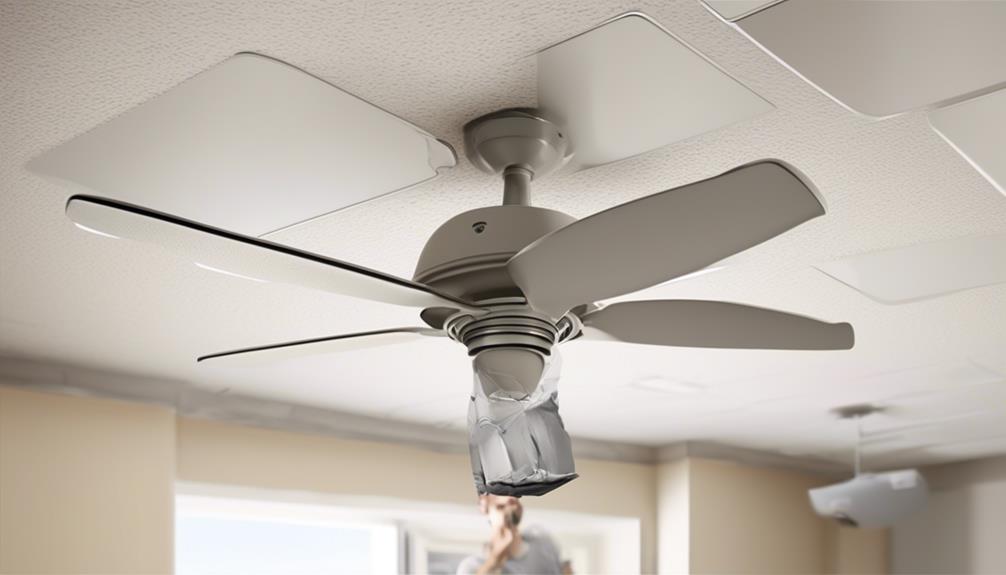
After completing the proper installation process, maintaining your AC or DC ceiling fan is essential to ensure its optimal performance and longevity. Both AC and DC ceiling fans require regular maintenance to keep them running smoothly and quietly.
To minimize noise and ensure quiet operation, it's important to follow some key maintenance practices.
One important maintenance requirement for both AC and DC ceiling fans is regular cleaning. Dust and debris can accumulate on the blades and motor, causing the fan to become noisy and less efficient. Regularly dusting the blades and wiping down the motor with a clean cloth can help prevent build-up and maintain quiet operation.
Another maintenance task is lubricating the fan's moving parts. Over time, the motor and other components may start to make noise due to friction. Applying lubricant to the bearings and other moving parts can reduce friction and noise, ensuring that the fan operates quietly.
Inspecting and tightening any loose screws or bolts is also crucial for maintaining a quiet and smooth-running ceiling fan. Loose components can cause vibrations and rattling noises, which can be easily resolved by tightening them.
Longevity
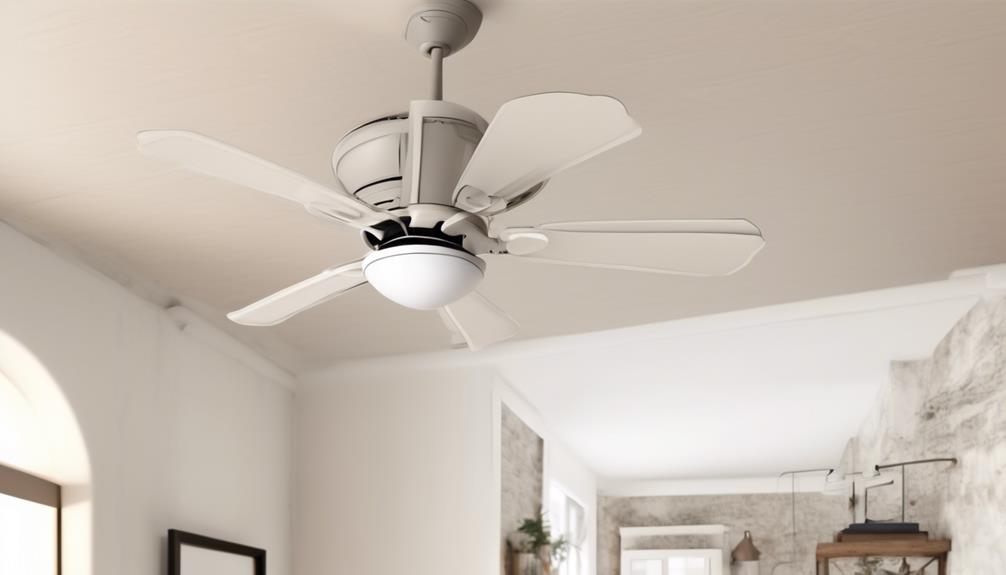
To ensure the longevity of your AC or DC ceiling fan, regular maintenance and proper care are essential. While both types of fans can provide years of reliable service, there are some differences in their longevity and maintenance needs that are worth considering.
Here is a comparison of the longevity of AC and DC ceiling fans:
- AC Ceiling Fans:
- Typically have a longer lifespan compared to DC fans.
- Can last anywhere from 10 to 15 years with proper maintenance.
- Require regular lubrication of the motor bearings to ensure smooth operation.
- May need occasional capacitor replacements as they can wear out over time.
- DC Ceiling Fans:
- Tend to have a shorter lifespan compared to AC fans.
- Generally last around 5 to 10 years with proper maintenance.
- Don't require motor bearing lubrication as they use brushless motors.
- May require occasional replacement of electronic components such as the control module or motor controller.
To ensure the longevity of your ceiling fan, it's important to follow the manufacturer's maintenance guidelines. Regular cleaning, checking for loose connections, and addressing any issues promptly can help extend the lifespan of your fan regardless of whether it's an AC or DC model.
Design Options
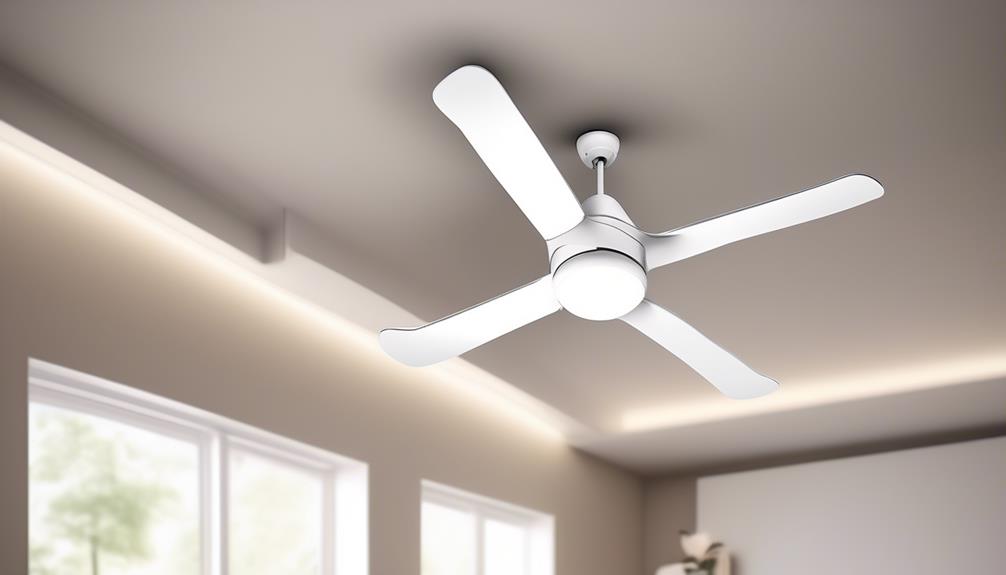
When considering design options for ceiling fans, there are a variety of styles and finishes available to suit any aesthetic preference. Ceiling fans come in various sizes, shapes, and colors, allowing homeowners to choose a design that complements their existing decor or sets the tone for a new interior design project. From traditional to contemporary, rustic to sleek, there's a design option for every taste and style.
In addition to the wide range of styles, ceiling fans also offer different finish options. These finishes can include brushed nickel, bronze, chrome, and even wood. The choice of finish can greatly impact the overall look and feel of a room, making it an important consideration when selecting a ceiling fan.
When it comes to cost, the design options available for ceiling fans can vary. More intricate designs or finishes may come at a higher price point, while simpler designs or finishes may be more budget-friendly. It's important to consider the cost in relation to the desired design and finish, as well as the overall budget for the project.
Eco-Friendliness
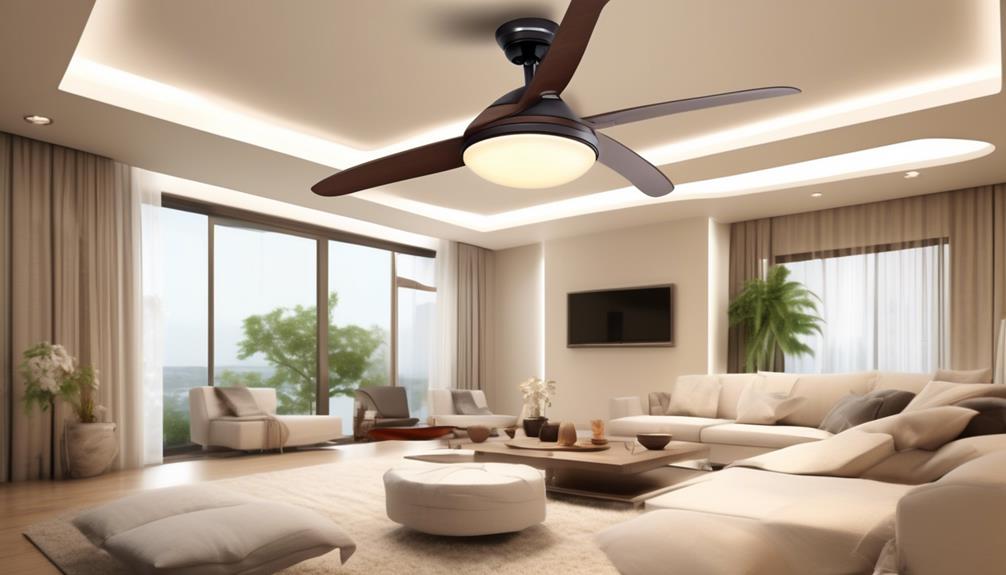
Ceiling fans not only offer a wide range of design options, but they also provide an eco-friendly cooling solution for any space. When it comes to the environmental impact, ceiling fans are a more sustainable choice compared to air conditioners. Here are a few reasons why:
- Energy efficiency rating:
Ceiling fans have a high energy efficiency rating, meaning they consume less electricity to produce the same level of cooling as air conditioners. This reduces overall energy consumption and lowers greenhouse gas emissions. AC ceiling fans, which are powered by alternating current, are generally more energy-efficient than DC ceiling fans. They're designed to convert electrical energy into mechanical energy at a higher efficiency, resulting in less energy wastage.
- Reduced carbon footprint:
Frequently Asked Questions
Can an AC Ceiling Fan Be Converted to a DC Ceiling Fan?
Yes, an AC ceiling fan can be converted to a DC ceiling fan by replacing the motor. The advantages of DC ceiling fans include energy efficiency, quiet operation, and variable speed control.
How Does the Noise Level of a Ceiling Fan Affect Its Performance?
When considering the noise level of a ceiling fan, it is important to understand its impact on performance. Excessive noise can indicate inefficient operation and compromise the fan's ability to provide optimal air circulation.
Are There Any Speed Control Options Available for Both AC and DC Ceiling Fans?
There are speed control options available for both AC and DC ceiling fans. For example, some fans can be controlled using a remote control, while others can be controlled through a wall switch.
What Factors Should Be Considered When Choosing a Ceiling Fan for Eco-Friendliness?
When considering the eco-friendliness of a ceiling fan, important factors include energy efficiency and material sustainability. These aspects should be carefully considered to ensure the fan is environmentally responsible and meets our desired standards.
Are There Any Design Options Available for Ceiling Fans That Are Both Stylish and Functional?
When it comes to stylish ceiling fan options, there are plenty of energy efficient choices available. From sleek designs to modern finishes, these fans not only add aesthetic appeal but also help conserve energy.
Conclusion
In conclusion, when comparing AC and DC ceiling fans, it's evident that DC fans are more efficient and energy-saving, with motor efficiency rates of up to 80%. This translates to significant energy cost savings for consumers.
Additionally, DC fans offer better speed control options and have lower noise levels. With their longer lifespan and eco-friendly design options, DC fans are a superior choice for those seeking a high-performing and sustainable cooling solution for their homes.
- About the Author
- Latest Posts
Introducing Ron, the home decor aficionado at ByRetreat, whose passion for creating beautiful and inviting spaces is at the heart of his work. With his deep knowledge of home decor and his innate sense of style, Ron brings a wealth of expertise and a keen eye for detail to the ByRetreat team.
Ron’s love for home decor goes beyond aesthetics; he understands that our surroundings play a significant role in our overall well-being and productivity. With this in mind, Ron is dedicated to transforming remote workspaces into havens of comfort, functionality, and beauty.
Appliances
Door Handle Height
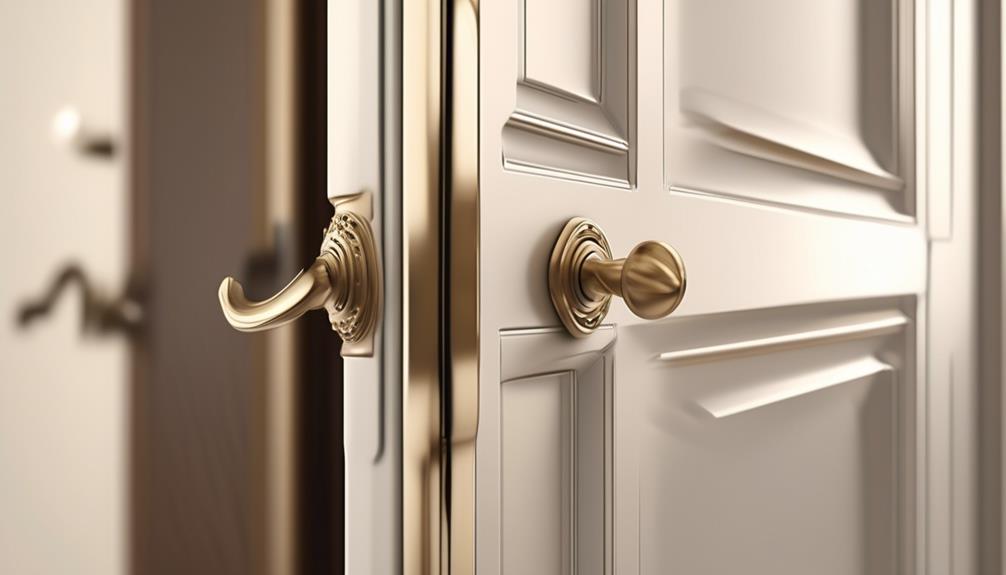
Upon initial inspection, a door handle may appear to be a minor aspect in the overall realm of architecture and design.
However, the height of a door handle can symbolize the broader principles of inclusivity and accessibility within a space.
Have you ever considered the impact that door handle height can have on the comfort and ease of use for individuals of varying ages and abilities?
From the practical implications to the psychological effects, the significance of door handle height extends far beyond mere convenience.
Key Takeaways
- Optimal door handle height ensures accessibility, comfort, and safety.
- Door handle height influences accessibility and convenience.
- Door handle height should consider children's reach, elderly accessibility, and adult ergonomics.
- Ergonomic design and functionality of door handles enhance user experience.
Importance of Optimal Door Handle Height
We believe that setting the optimal door handle height is crucial for ensuring accessibility, comfort, and safety for all individuals who interact with the door. Design aesthetics play a significant role in determining the door handle height. A well-designed handle not only adds to the overall visual appeal of the door but also enhances the user comfort. The handle should be positioned at a height that complements the design of the door while ensuring ease of use for individuals of varying heights and abilities.
Safety concerns are paramount when determining the door handle height. Proper positioning can prevent accidents and injuries by ensuring that the handle is easily reachable without the need for excessive stretching or bending. This is especially important in emergency situations where quick access is critical.
Considering maintenance requirements is also essential. The handle should be placed at a height that reduces the accumulation of dirt and grime, making it easier to clean and maintain. This not only contributes to the door's aesthetic appeal but also ensures its longevity and functionality.
Impact on Accessibility and Convenience

The optimal door handle height not only impacts safety and maintenance but also significantly influences accessibility and convenience for individuals interacting with the door. Design implications arising from the door handle height play a crucial role in ensuring that the door can be easily accessed by a wide range of users, including those with physical limitations.
Functional limitations can be mitigated by carefully considering the placement of the door handle. For instance, a lower door handle can cater to wheelchair users and children, while an ergonomic design can enhance ease of use for all individuals.
Additionally, the convenience of the door handle height is closely tied to the door's overall aesthetic and functionality. A well-placed handle not only enhances the visual appeal of the door but also ensures that it can be effortlessly operated.
Considerations for Different Age Groups
As we consider the door handle height for different age groups, it's crucial to think about children's reach, elderly accessibility, and adult ergonomics.
Ensuring that door handles are at an appropriate height for children can promote independence and safety.
Similarly, adjusting handle height for elderly individuals can enhance accessibility and comfort, while also considering the ergonomic needs of adults for everyday convenience.
Children's Reach
Considering the varying heights at which children can comfortably reach, it's imperative to account for the specific age group when determining the ideal placement of door handles.
For children's safety, accessibility standards should be met to ensure that door handles are easily reachable.
For toddlers and young children, door handles should be placed lower, typically around 28 to 36 inches from the floor, allowing them to access the doors independently.
As children grow, the handle height can be adjusted to accommodate their increasing height and reach.
It's important to consider the ergonomics and aesthetics of the door handle placement, ensuring that it aligns with the overall design while being functional for different age groups.
Elderly Accessibility
Taking into account the varying heights at which children can comfortably reach, we must also consider the accessibility needs of the elderly when determining the ideal placement of door handles.
For elderly comfort, door handles should be positioned at a height that allows for easy and natural access without the need for excessive reaching or bending. Accessibility challenges for the elderly include decreased strength and flexibility, as well as potential mobility issues.
To address these challenges, door handles should be placed at a height that allows for effortless operation, promoting independence and ease of movement. Additionally, the design and aesthetics of the handles should complement the overall environment, providing a sense of elegance while ensuring functionality.
Adult Ergonomics
We carefully consider the ergonomic needs of adults in designing door handle placement, ensuring comfortable and effortless operation for individuals of varying age groups.
In an ergonomic workplace, furniture design plays a crucial role in promoting the well-being of adults.
When designing door handles for adults, we take into account factors such as hand size, grip strength, and range of motion. The handle should be positioned at a height that allows for natural and comfortable use, minimizing strain on the wrist and arm. The shape and texture of the handle are also important, providing a secure grip and tactile feedback.
Additionally, the placement of the handle should facilitate smooth and intuitive operation, enhancing the overall user experience.
Ergonomic Design and User Experience
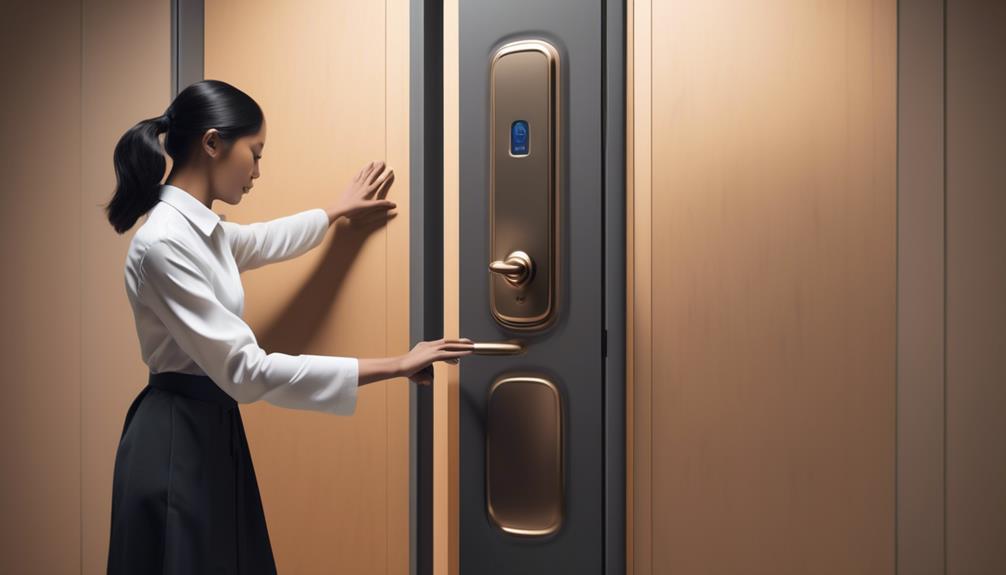
To enhance the user experience and promote ergonomic design, careful consideration must be given to the placement and functionality of door handles. Ergonomic principles play a crucial role in ensuring user satisfaction when interacting with door handles. The design should accommodate the natural movements of the hand and arm, minimizing strain and discomfort.
Lever-style handles, for instance, are often preferred over traditional doorknobs because they're easier to operate, especially for individuals with limited hand strength or mobility. The height at which the handle is installed also significantly impacts user experience. It should be positioned at a height that allows for effortless operation without requiring excessive bending or reaching.
Additionally, the material and texture of the handle should be carefully chosen to provide a comfortable grip and tactile feedback. Aesthetically, the design of the handle should complement the overall style of the door and its surroundings, creating a cohesive and visually appealing environment.
Ultimately, a well-designed door handle not only enhances the functionality of the door but also contributes to the overall ergonomic and aesthetic experience for the user.
Inclusive Environments and Universal Design
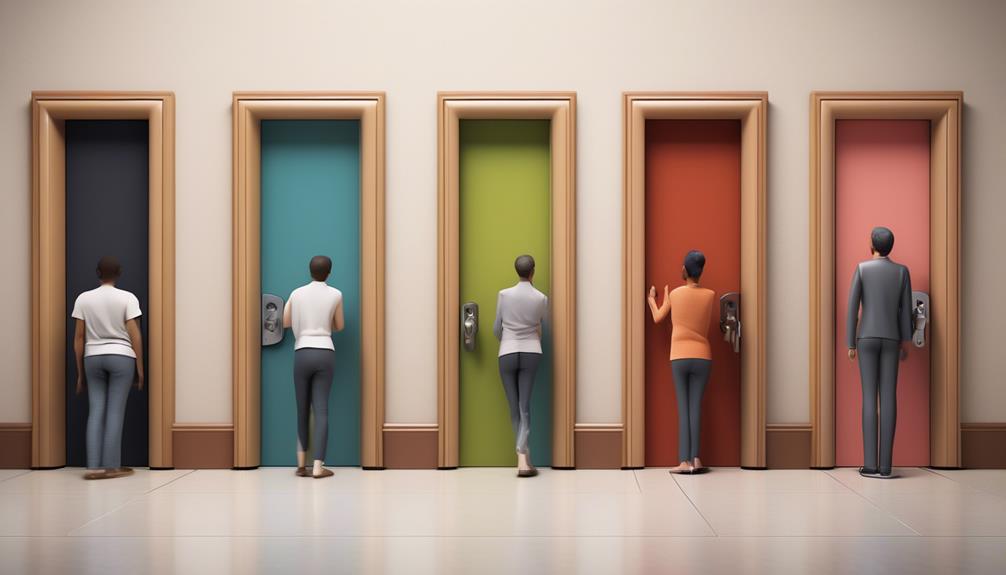
Considering the importance of ergonomic design and user experience, creating inclusive environments and incorporating universal design principles becomes essential for ensuring accessibility and usability for all individuals. Designing for all requires adhering to accessibility standards and considering the diverse needs of people. Universal design is not just about complying with regulations; it's about going beyond to create spaces and products that are functional and aesthetically pleasing for everyone, regardless of age, size, ability, or disability.
| Principles of Universal Design | Description |
|---|---|
| Equitable Use | The design is useful and marketable to people with diverse abilities. |
| Flexibility in Use | The design accommodates a wide range of individual preferences and abilities. |
| Simple and Intuitive Use | Use of the design is easy to understand, regardless of the user's experience, knowledge, language skills, or current concentration level. |
Inclusive environments and universal design principles are about maximizing the usability of spaces and products while minimizing barriers and exclusion. By considering the diverse needs of individuals, we can create environments that are not only accessible but also aesthetically pleasing and practical for everyone.
Factors Influencing Ideal Door Handle Height

When determining the ideal height for door handles, it's crucial to consider ergonomic factors and the diverse needs of potential users. Factors such as architectural standards and interior design principles play a significant role in determining the best height for door handles.
Architectural standards provide guidelines for door handle height, taking into account factors such as building codes and accessibility requirements. These standards ensure that door handle height meets the needs of individuals with varying abilities and mobility challenges.
In addition to architectural standards, interior design principles also influence the ideal door handle height. Interior design considers the aesthetic appeal and functionality of door handles within a space. The placement of door handles is crucial in maintaining a cohesive design while ensuring ease of use for occupants.
Considering these factors, the ideal height for door handles should align with both architectural standards and interior design principles. This approach ensures that door handles aren't only accessible and functional but also contribute to the overall aesthetic of the space.
Achieving the ideal door handle height involves a thoughtful balance between ergonomic considerations, architectural standards, and interior design principles.
Practical Applications and Installation Considerations

As we explore practical applications and installation considerations for door handles, it's essential to ensure that the chosen height aligns with both architectural standards and interior design principles. When installing door handles, there are various factors to consider, including installation challenges and maintenance requirements. To assist in the decision-making process, we have compiled a table outlining these considerations.
| Consideration | Description |
|---|---|
| Installation Height | The standard height for door handle installation is typically 34 to 48 inches above the finished floor, ensuring accessibility and usability. |
| Hand Orientation | Consider the orientation of the door swing and the user's dominant hand to determine the most practical placement for the handle. |
| Maintenance Needs | Choose durable materials and finishes that can withstand frequent use and exposure to environmental factors, minimizing maintenance requirements. |
Installation challenges may arise from non-standard door sizes, intricate hardware, or specific architectural features. Moreover, maintenance requirements should be considered when selecting materials and finishes to ensure longevity and ease of care. By carefully addressing these practical considerations, the installation of door handles can seamlessly integrate functionality and aesthetic appeal within any space.
Frequently Asked Questions
What Are the Historical Reasons Behind the Standard Door Handle Height and How Has It Evolved Over Time?
We've studied the historical evolution of ergonomic design, tracing the development of standard door handle height over time. This has provided valuable insight into the factors influencing the design and functionality of door handles.
Our research has shed light on the practical and aesthetic considerations that have shaped the standard door handle height, offering a comprehensive understanding of this often-overlooked aspect of interior design.
Are There Any Cultural or Regional Differences in Preferred Door Handle Heights?
Cultural influences can significantly impact design preferences. Ergonomic design, in particular, varies across cultures and regions. Understanding these differences is crucial for creating products that meet diverse needs.
How Does the Material and Texture of the Door Handle Impact Its Usability for Different Individuals?
Material impact and texture usability are crucial factors in door handle design. The choice of material affects the handle's durability and maintenance, while the texture can enhance grip and comfort.
For instance, a smooth metal handle may be sleek but slippery, posing usability issues for some individuals. Conversely, a textured rubber handle could provide better grip and usability, especially for those with mobility challenges.
Considering these aspects ensures a well-designed, functional door handle for all.
Can the Color and Visibility of the Door Handle Affect Its Accessibility for People With Visual Impairments?
Color contrast and visibility are crucial for people with visual impairments. Tactile indicators and ergonomic design enhance accessibility.
Imagine a door handle as a beacon, guiding us through a sea of visual information. We consider color combinations, ensuring high contrast for easy identification.
Tactile indicators provide additional guidance, making the handle easily locatable by touch.
Ergonomic design ensures comfort and ease of use for all.
What Are the Maintenance and Cleaning Considerations for Door Handles at Different Heights?
When it comes to maintenance, durability, and cleaning of door handles at different heights, it's essential to consider accessibility, usability, and visibility.
We prioritize regular inspections for wear and tear, ensuring that all handles are clean and well-maintained.
Durability is key, so we opt for high-quality materials.
Cleaning routines are tailored to each handle's location and use, ensuring both functionality and aesthetic appeal.
Conclusion
After all, who needs a door handle that's actually accessible and convenient? Let's just keep making them at random heights and watch people struggle to open doors.
It's not like different age groups or people with disabilities have different needs, right? Who cares about ergonomic design and user experience anyway?
Let's just stick to the status quo and ignore the importance of inclusive environments and universal design.
It's not like we want everyone to feel welcome and comfortable, right?
- About the Author
- Latest Posts
Introducing Ron, the home decor aficionado at ByRetreat, whose passion for creating beautiful and inviting spaces is at the heart of his work. With his deep knowledge of home decor and his innate sense of style, Ron brings a wealth of expertise and a keen eye for detail to the ByRetreat team.
Ron’s love for home decor goes beyond aesthetics; he understands that our surroundings play a significant role in our overall well-being and productivity. With this in mind, Ron is dedicated to transforming remote workspaces into havens of comfort, functionality, and beauty.
Appliances
How Long Does Carpet Last

As you walk through a house, you can almost feel the softness of the carpet under your feet, imagining the cozy comfort it offers. However, have you ever paused to think about how long that carpet will endure?
It's a question that often lingers in the back of our minds, especially when we start to notice signs of wear and tear. Understanding the factors that contribute to the longevity of carpet can help us make informed decisions about maintenance, replacement, and ultimately, the overall lifespan of this essential home feature.
Key Takeaways
- Regular vacuuming and professional cleaning are essential for maintaining carpet longevity.
- Different carpet fiber types, such as nylon, polyester, polypropylene, and wool, have unique characteristics and maintenance requirements.
- Choosing high-quality, durable materials can enhance the carpet's ability to withstand environmental stressors.
- Maintenance significantly extends the lifespan of carpets by preventing damage and preserving their appearance.
Factors Affecting Carpet Longevity
We have found that regular vacuuming and professional cleaning are essential for maintaining the longevity of carpets.
Additionally, understanding the different carpet fiber types is crucial for ensuring the durability of your flooring. Carpets can be made from various materials such as nylon, polyester, polypropylene, and wool, each with its own unique characteristics and maintenance requirements.
It's important to consider the environmental impact of these different fiber types as well. For instance, wool carpets are biodegradable and renewable, making them a more sustainable choice compared to synthetic fibers.
Moreover, the environmental impact extends beyond just the fiber type. The manufacturing process, transportation, and eventual disposal of carpets all contribute to their overall ecological footprint.
By choosing carpets made from recycled materials or opting for eco-friendly production methods, such as low-energy manufacturing or water conservation practices, we can minimize the environmental impact of carpeting.
Understanding the intricacies of carpet fiber types and their environmental implications empowers us to make informed decisions that not only prolong the lifespan of our carpets but also reduce their ecological footprint.
Carpet Material and Quality
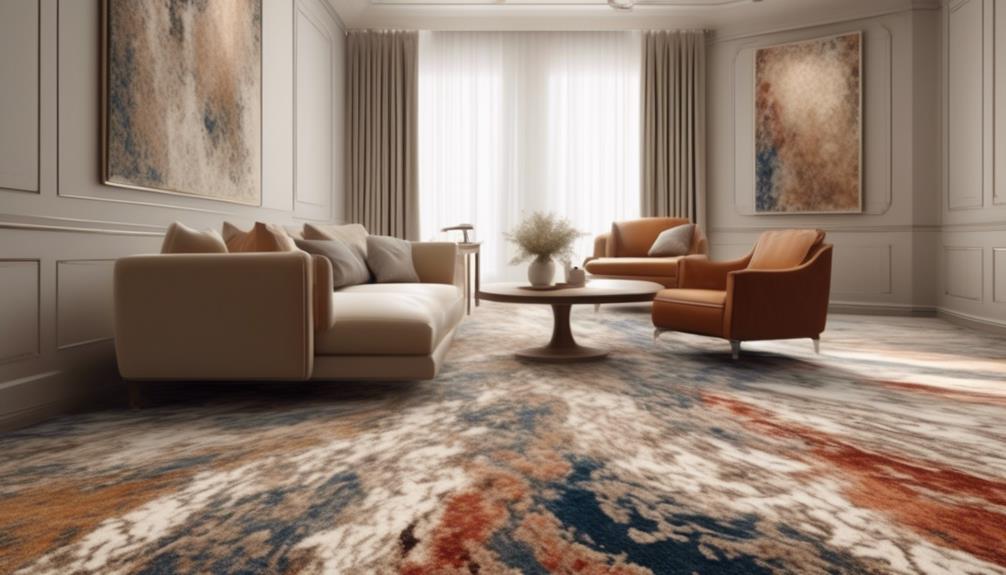
Carpet material and quality play a crucial role in determining the longevity and performance of flooring, with factors such as fiber type, density, and manufacturing processes directly influencing its durability and resilience. The choice of carpet material significantly impacts its longevity. For instance, wool carpets are known for their durability and natural soil resistance, while nylon carpets offer exceptional resilience and stain resistance. Additionally, the quality of the carpet, which encompasses factors such as the density of fibers and the manufacturing processes employed, greatly influences its ability to withstand wear and tear. Carpets with higher density tend to be more durable due to the increased amount of yarn in a given area, providing better support for the carpet pile. Moreover, manufacturing processes that prioritize quality, such as tightly twisting the fibers and applying advanced stain-resistant treatments, contribute to the overall longevity of the carpet.
| Carpet Material | Durability | Quality |
|---|---|---|
| Wool | High | Excellent |
| Nylon | Excellent | Good |
| Polyester | Moderate | Fair |
Impact of Maintenance on Carpet Lifespan
Regular and thorough maintenance significantly extends the lifespan of carpets by preventing the accumulation of dirt and preserving the integrity of the fibers. Regular vacuuming is essential for removing surface dirt, dust, and allergens that can damage carpet fibers over time. It also helps to prevent matting and crushing of the carpet pile, which can make the carpet look worn and tired. Vacuuming should be done at least once a week in low-traffic areas and more frequently in high-traffic areas.
In addition to regular vacuuming, professional deep cleaning is crucial for maintaining the longevity of carpets. Professional cleaning removes embedded dirt, stubborn stains, and allergens that regular vacuuming may not effectively eliminate. This deep cleaning process also helps to rejuvenate the carpet fibers, restoring their texture and appearance. Professional deep cleaning should be performed at least once a year, or more frequently in high-traffic areas or households with pets.
Understanding Carpet Usage Patterns

We must consider the wear and tear that carpets endure over time, as well as the specific traffic patterns within a given space. These usage patterns directly impact the overall lifespan of the carpet and influence the need for maintenance and cleaning.
Understanding the frequency of cleaning required in high-traffic areas is essential for preserving the quality and durability of the carpet.
Wear and Tear
Analyzing the wear and tear on carpet involves observing the distribution of foot traffic and identifying high-traffic areas. This helps in understanding how the carpet is being used and where the most stress is being placed.
Key points to consider when assessing carpet wear and tear:
- Foot traffic patterns: Regularly used pathways and areas where people often stand, such as in front of furniture or entryways, are prone to more wear and tear.
- Furniture placement: Heavy furniture can cause localized stress on the carpet, leading to premature aging and wear.
- Spills and stains: Areas with frequent spills or stains may have hidden damage, such as mold or mildew growth underneath the carpet.
- Sunlight exposure: Carpets in areas with prolonged exposure to sunlight can experience fading and deterioration.
Understanding these usage patterns is crucial for maintaining and extending the lifespan of the carpet.
Traffic Patterns
Understanding carpet usage patterns involves closely observing the distribution of foot traffic and identifying high-traffic areas to determine the impact of usage on the carpet's lifespan. Wear patterns, such as those caused by repetitive footsteps in specific areas, can significantly affect the longevity of the carpet.
High traffic areas, like hallways, entryways, and main living spaces, are particularly prone to wear patterns due to the constant flow of people. These areas often show visible signs of wear, including flattened or frayed carpet fibers.
By monitoring traffic patterns, we can anticipate and address wear and tear more effectively. Implementing preventative measures, such as using rugs or runners in high traffic zones, can help distribute the impact of foot traffic and prolong the life of the carpet.
Understanding and managing traffic patterns is crucial for maximizing the lifespan of your carpet.
Cleaning Frequency
Monitoring traffic patterns allows us to determine the optimal cleaning frequency necessary to maintain the carpet's longevity and appearance. Understanding household habits is crucial in establishing an effective cleaning schedule. Here are key points to consider:
- High Traffic Areas: Identify and focus on cleaning areas that receive the most foot traffic.
- Regular Vacuuming: Implement a routine vacuuming schedule to prevent dirt and debris from settling into the carpet fibers.
- Professional Services: Engage professional cleaning services at least once a year to ensure a thorough deep clean.
- Maintenance Benefits: Regular cleaning not only preserves the carpet's appearance but also extends its lifespan, reducing the need for premature replacement.
Signs of Wear and Tear

As carpets age, they may exhibit visible signs of wear and tear, such as matting, discoloration, and fraying along the edges. Color fading is a common occurrence in carpets, particularly in areas that are exposed to direct sunlight or high foot traffic. Over time, the vibrant hues of the carpet can gradually lose their intensity, resulting in a dull and faded appearance. This can be particularly noticeable in carpets made from natural fibers or those with darker colors.
Additionally, fraying edges are a clear indicator of a carpet's deteriorating condition. This typically occurs in high-traffic areas or places where the carpet meets a hard surface, such as near doorways. The constant friction and pressure can cause the carpet fibers to unravel and fray, leading to a ragged and unkempt appearance.
Furthermore, matting, which is the flattening and compression of carpet fibers, can result from heavy furniture or repetitive foot traffic. Matting can create an uneven and worn-out look, diminishing the overall aesthetic appeal of the carpet.
These visible signs of wear and tear serve as critical indicators of a carpet's age and condition, prompting the need for appropriate maintenance or replacement.
Professional Carpet Cleaning Benefits
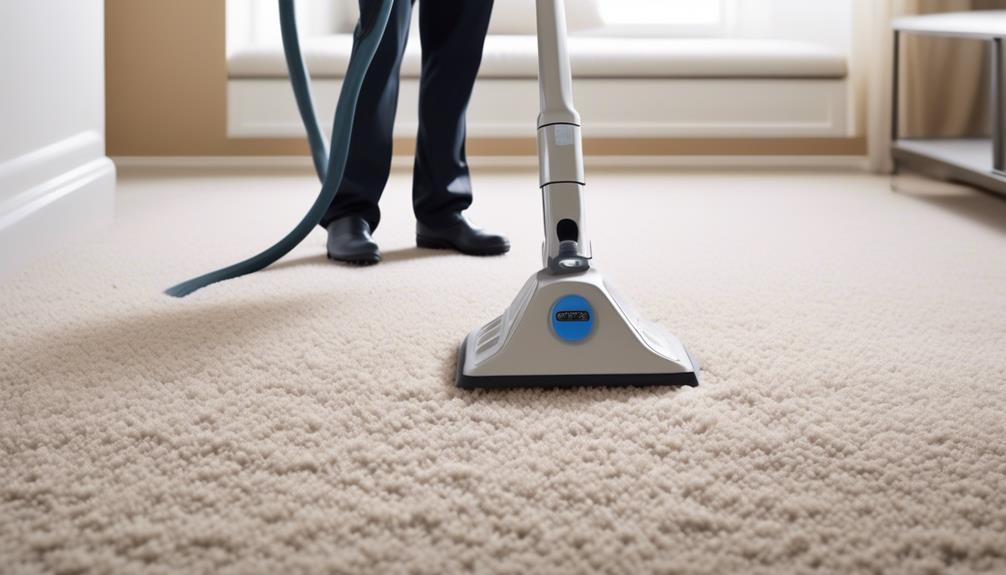
Regular professional carpet cleaning offers multiple benefits for both the longevity of your carpet and the quality of your indoor air.
Firstly, by removing deep-seated dirt, dust, and allergens, professional cleaning helps to maintain the integrity of the carpet fibers. This prevents premature wear and tear, ensuring that your carpet lasts longer.
Secondly, professional cleaning eliminates odors that may be trapped in the carpet fibers. This not only makes your carpet smell fresher but also contributes to a healthier indoor environment by removing any lingering smells that could potentially cause discomfort or allergies.
Lastly, professional cleaning enhances the overall appearance of your carpet. By removing stains and restoring the carpet's original color, it helps to make your carpet look cleaner and more aesthetically pleasing. This, in turn, contributes to a more inviting and enjoyable indoor space.
Extended Carpet Lifespan
To ensure the extended lifespan of your carpet, professional cleaning services provide numerous benefits that contribute to the maintenance and preservation of its quality and appearance. Professional carpet cleaning offers several advantages that significantly impact the longevity and sustainability of your carpets:
- Deep Cleaning: Professional services utilize advanced techniques to remove embedded dirt, allergens, and stains, which regular vacuuming can't effectively address.
- Fiber Protection: Specialized cleaning solutions and treatments help protect carpet fibers from wear and tear, maintaining their resilience and appearance over time.
- Prevention of Mold and Bacteria: Thorough cleaning inhibits the growth of mold, mildew, and bacteria, which can deteriorate carpet fibers and pose health risks.
- Enhanced Air Quality: Clean carpets contribute to improved indoor air quality by reducing the presence of allergens and pollutants, benefiting the overall health and well-being of occupants.
Improved Indoor Air Quality
Our professional carpet cleaning services utilize advanced techniques to thoroughly remove allergens and pollutants, contributing to a noticeable improvement in indoor air quality. By eliminating dust mites, pet dander, pollen, and other allergens that accumulate in carpets over time, our cleaning process significantly reduces the presence of airborne particles that can affect respiratory health.
This allergen reduction leads to improved air circulation within the indoor environment, creating a fresher and healthier atmosphere for inhabitants. Moreover, our meticulous cleaning methods remove trapped pollutants, such as dirt, dust, and insect feces, which can compromise air quality.
With improved indoor air quality, individuals can experience reduced allergy symptoms and respiratory issues, making our professional carpet cleaning an essential element in maintaining a healthy living space.
DIY Carpet Maintenance Tips
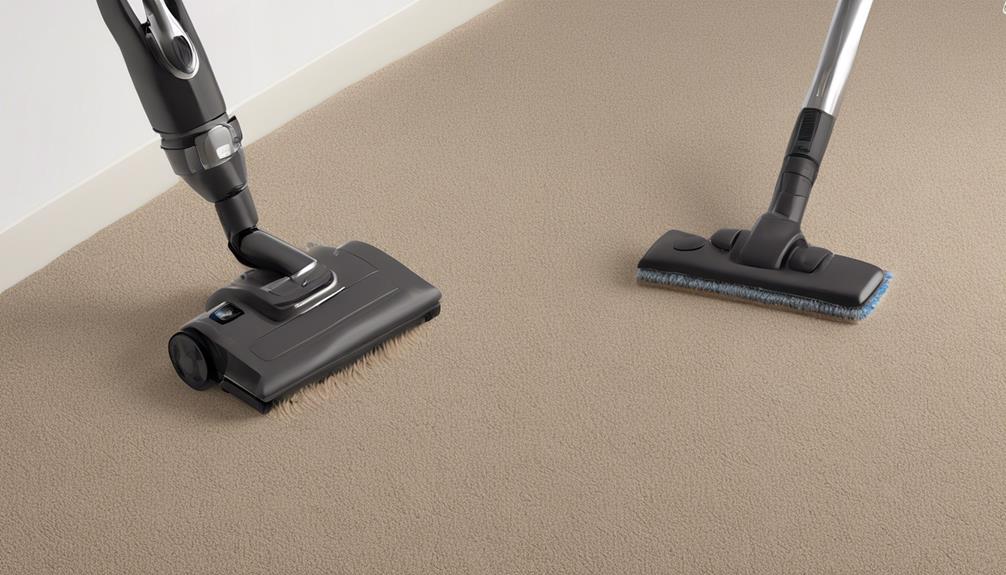
Implementing a routine carpet maintenance plan is essential for prolonging the lifespan of your carpet and preserving its appearance and functionality. To ensure your carpet stays in top condition, consider these DIY carpet maintenance tips:
- Regular Vacuuming: Vacuuming at least once a week helps remove dirt, dust, and debris that can damage carpet fibers and cause discoloration.
- Immediate Stain Removal: Promptly address any spills or stains using a carpet stain remover. Blot the affected area gently to prevent the stain from setting.
- Deep Cleaning: Schedule deep cleaning sessions every 12-18 months to remove embedded dirt and grime. Consider using a carpet cleaning machine or hire professional services for this task.
- Odor Control: Combat carpet odors by sprinkling baking soda before vacuuming. Additionally, ensure proper ventilation and consider using carpet deodorizers sparingly.
Adhering to these maintenance practices won't only extend the life of your carpet but also contribute to a healthier indoor environment. Regular upkeep is key to preventing permanent damage and maintaining the aesthetic appeal of your carpet.
Protective Measures for High-Traffic Areas
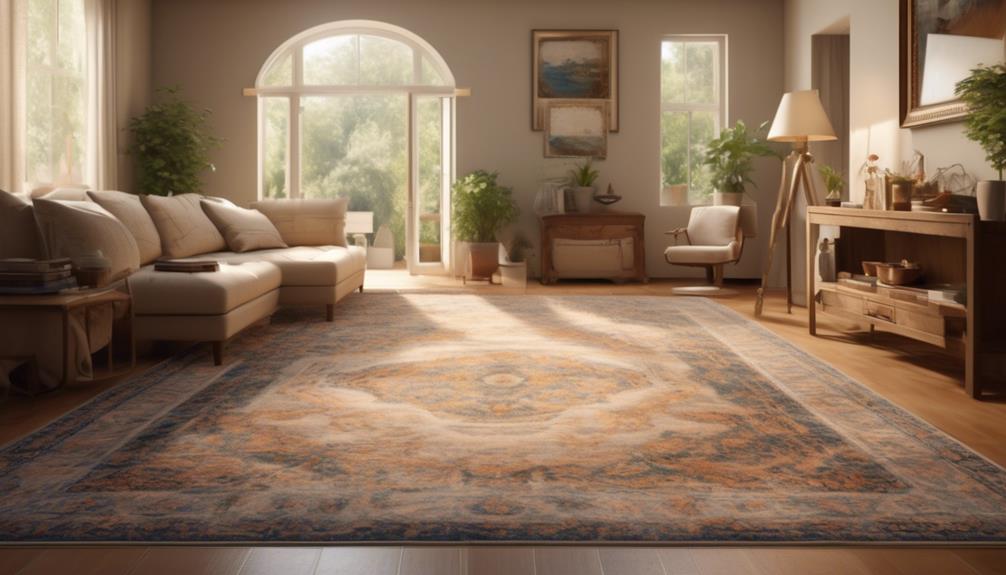
In high-traffic areas, it's crucial to employ protective measures that can effectively mitigate wear and tear on the carpet. Rug protection is essential in preserving the lifespan of carpets in such areas. One effective method is the use of area rugs or runners to cover the most heavily trafficked sections. These rugs act as a barrier, absorbing much of the impact and reducing direct contact between foot traffic and the carpet fibers.
Additionally, the strategic placement of entry mats at all entrances can significantly reduce the amount of dirt and debris that reaches the carpet, thus minimizing abrasive damage and soiling.
Furthermore, floor covering maintenance plays a vital role in the preservation of high-traffic carpeted areas. Regular vacuuming is essential to prevent the accumulation of dirt and grit that can accelerate wear. In addition to routine vacuuming, professional cleaning should be scheduled at regular intervals to deep clean and rejuvenate the carpet fibers. This proactive approach not only maintains the carpet's appearance but also extends its overall lifespan.
Environmental Influences on Carpet Longevity
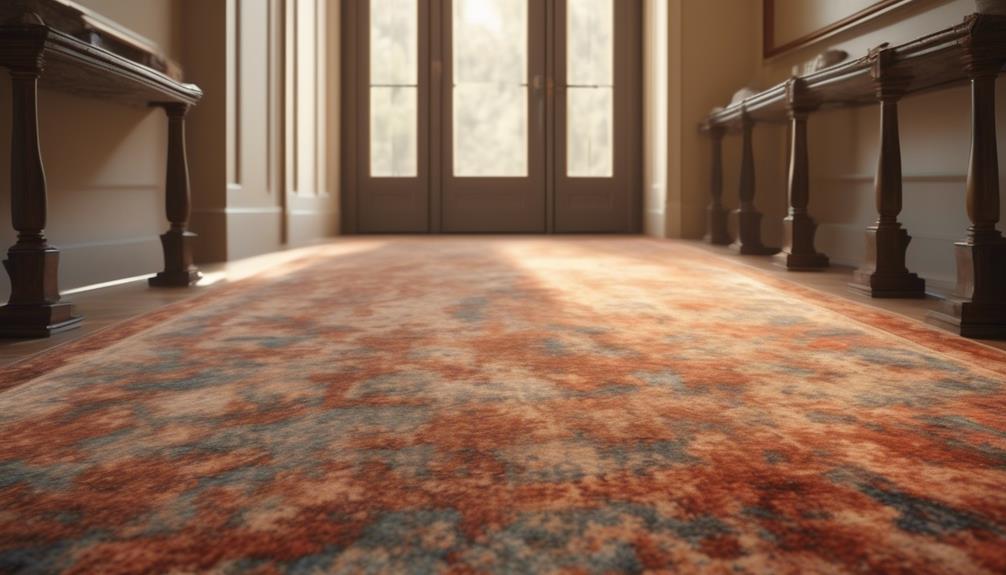
Environmental factors significantly impact the longevity of carpets. Exposure to sunlight, humidity, and air pollutants can deteriorate carpet fibers over time.
Sunlight: Prolonged exposure to sunlight can cause fading and weaken the carpet fibers. Ultraviolet radiation breaks down the chemical bonds in the carpet fibers, leading to color loss and reduced structural integrity.
Humidity: High levels of humidity can promote mold and mildew growth. This not only affects the appearance of the carpet but also weakens the fibers. Additionally, excessive moisture can lead to delamination, where the carpet layers separate, causing irreversible damage.
Air Pollutants: Pollutants such as dust, dirt, and airborne particles can accumulate in the carpet fibers, causing abrasion and fiber damage over time. Chemical pollutants can also react with the carpet materials, accelerating degradation.
Material durability plays a critical role in mitigating the environmental impacts on carpet longevity. Choosing high-quality, durable materials can enhance the carpet's ability to withstand environmental stressors, thus prolonging its lifespan.
Regular maintenance and proper cleaning routines are also essential in combating the detrimental effects of environmental factors on carpet longevity.
Effective Stain Prevention

To effectively prevent stains on carpets, it's imperative to apply a quality stain-resistant treatment during the manufacturing process, ensuring a protective barrier against spills and soiling. Stain-resistant treatments, such as fluorocarbon or other protective coatings, can be applied to carpet fibers to repel liquids and prevent them from being absorbed. These treatments form a shield around the fibers, making it easier to clean up spills before they have a chance to set in and become stains.
In addition to stain-resistant treatments, regular vacuuming techniques play a crucial role in preventing stains on carpets. Vacuuming removes dirt and debris that can attract and hold onto stains, preventing them from becoming deeply embedded in the carpet fibers. It's recommended to use a vacuum cleaner with a rotating brush or beater bar to effectively lift and remove debris from the carpet.
Furthermore, vacuuming high-traffic areas and spots where spills are more likely to occur can significantly reduce the risk of stains.
Carpet Replacement Considerations
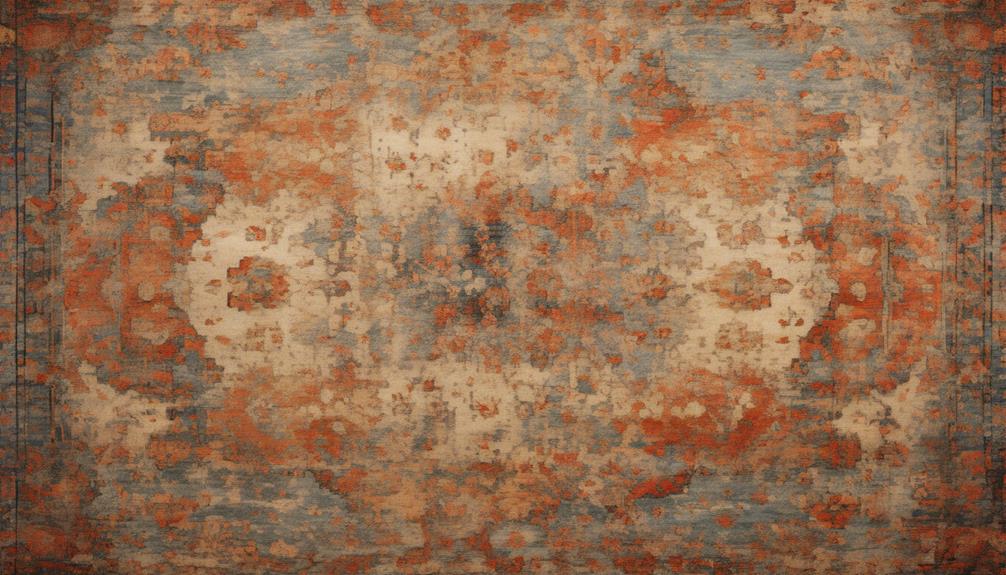
When considering the lifespan of a carpet, it's crucial to assess various factors that can impact its longevity.
The cost of replacement and the timing for installing new carpet are essential considerations in ensuring a smooth transition.
Understanding these points will help homeowners make informed decisions about when and how to replace their carpet.
Carpet Lifespan Factors
Considering the heavy foot traffic and regular wear and tear, the durability of the carpet heavily influences our replacement considerations. Factors impacting carpet durability include:
- Fiber type: The type of fiber used in the carpet, such as nylon, polyester, or wool, greatly affects its longevity and resilience.
- Maintenance and cleaning: Regular vacuuming, professional cleaning, and prompt stain removal can significantly extend the lifespan of the carpet.
- Padding quality: High-quality padding provides better support for the carpet, reducing wear and tear from foot traffic and furniture.
- Installation: Proper installation, including stretching and securing the carpet correctly, ensures its durability over time.
Understanding these factors is crucial for maximizing the lifespan of the carpet and making informed decisions about replacement.
Cost of Replacement
Exploring the longevity of the carpet, understanding the cost of replacement is a crucial aspect of informed decision-making regarding carpet durability and maintenance. When considering the cost of replacement, it's essential to compare the prices of different carpet types and the associated installation process. Below is a cost comparison table to provide a general overview of the replacement expenses for different carpet types.
| Carpet Type | Cost (per square foot) | Installation Process |
|---|---|---|
| Nylon | $2.50 – $6.00 | Professional installation recommended |
| Polyester | $1.50 – $3.50 | DIY or professional installation options |
| Wool | $5.00 – $10.00 | Professional installation recommended |
Understanding the cost comparison and the installation process can help make an informed decision when replacing your carpet.
Timing for New Carpet
In our experience, timely replacement of carpets is essential for maintaining a fresh and inviting atmosphere in any space. When considering the timing for new carpet, several factors come into play to ensure optimal results:
- Wear and Tear: Regular foot traffic and use can lead to visible signs of wear, such as matting or fraying.
- Stains and Spills: Despite regular cleaning, persistent stains and spills can detract from the overall appearance of the carpet.
- Allergen Accumulation: Over time, carpets can accumulate allergens, dust, and other particles, impacting indoor air quality.
- Style and Design Updates: As interior trends evolve, updating carpets can enhance the aesthetic appeal and overall ambiance of a room.
Understanding these longevity factors is crucial in determining the appropriate timing for carpet replacement.
Prolonging Carpet Lifespan
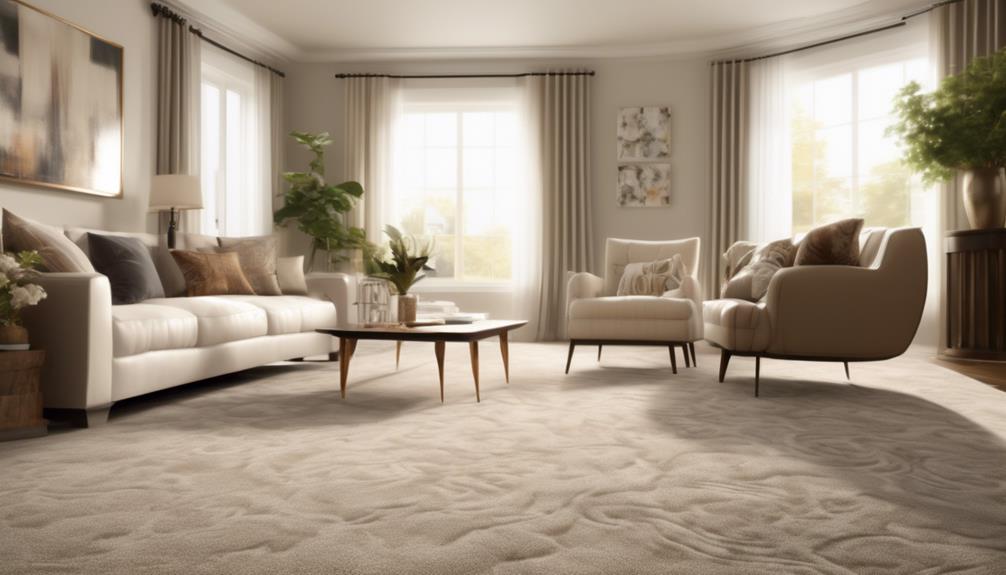
To extend the lifespan of your carpet, it's essential to implement proper maintenance and cleaning techniques. Stain prevention is a crucial aspect of carpet care. Utilize stain-resistant treatments and promptly clean up any spills to prevent them from setting into the fibers. Regular vacuuming is also key to preventing dirt and debris from becoming ground into the carpet, which can lead to staining over time. Additionally, consider placing rugs or mats in high-traffic areas to provide an extra layer of protection for the carpet. High traffic protection can significantly reduce wear and tear.
In addition to regular cleaning and stain prevention, professional carpet cleaning is vital for prolonging its lifespan. Deep cleaning by a professional can remove deeply embedded dirt and allergens that regular vacuuming and cleaning may miss. This not only enhances the appearance of the carpet but also helps maintain its structural integrity.
Furthermore, it's important to follow the manufacturer's guidelines for care and maintenance to ensure that the carpet remains in top condition. By implementing these maintenance and cleaning techniques, you can significantly prolong the lifespan of your carpet and keep it looking fresh for years to come.
Is the Longevity of Carpet Dependent on Replacement Frequency?
The longevity of carpet depends on how often to replace carpet. Frequent replacements can extend its lifespan, ensuring a fresh look and maintaining its quality. Consulting with a professional can help determine the ideal replacement frequency based on usage and foot traffic.
Frequently Asked Questions
Can I Use the Same Carpet in Different Areas of My Home With Varying Levels of Foot Traffic?
We can use the same carpet in different areas of our home with varying levels of foot traffic, but it's important to consider carpet durability and colorfastness.
High traffic areas may require a more resilient and stain-resistant carpet, while low traffic areas can accommodate a softer and more luxurious option.
It's essential to choose a carpet that can withstand the wear and tear of each specific area while maintaining its appearance over time.
Are There Any Specific Carpet Maintenance Techniques for Households With Pets?
When dealing with pet shedding, cleaning becomes a crucial aspect of carpet maintenance. Regular vacuuming with a high-quality vacuum cleaner designed for pet hair removal is essential.
Additionally, using enzymatic cleaners can help control odors and prevent stains caused by pet accidents. It's important to address any accidents promptly to prevent them from seeping into the carpet fibers.
Following these techniques can help maintain a clean and fresh carpet in households with pets.
How Does Humidity and Climate Affect the Longevity of Carpet?
Climate and humidity play significant roles in the durability of carpet. Proper installation and maintenance are crucial to combating the adverse effects of fluctuating moisture levels.
Humidity can lead to mold and mildew, affecting carpet longevity. In high-humidity regions, carpets may experience faster wear and tear.
Understanding the impact of climate and humidity on carpet is essential for ensuring its longevity. It's important to consider these factors when selecting and maintaining carpet in different environments.
Is It Possible to Extend the Lifespan of Older Carpet Through Repairs or Restorations?
We've found that extending the lifespan of older carpet is possible through strategic interventions. Carpet patching and stretching can target specific areas of wear and tear, while professional cleaning and reconditioning can revitalize the entire carpet.
These techniques not only enhance longevity but also improve the overall appearance and functionality. It's like giving an old masterpiece a new frame and a fresh coat of varnish, preserving its beauty for years to come.
What Impact Does Furniture Placement and Rearranging Have on Carpet Wear and Tear?
Furniture placement and rearranging can significantly impact carpet wear and tear. Constant foot traffic and varying levels of humidity in pet households can affect carpet longevity. Maintenance techniques and climate effects play a role in preserving carpets.
Regular rearranging can help distribute wear more evenly. Proper maintenance, like regular cleaning and timely repairs, can extend the lifespan of carpets. Understanding these factors is essential for mastering carpet care.
Conclusion
In conclusion, a carpet's lifespan is like a well-tended garden, requiring careful nurturing and maintenance to thrive.
By understanding the factors that affect longevity, implementing effective maintenance strategies, and being mindful of usage patterns and environmental influences, one can prolong the life of their carpet.
Just as a gardener tends to their plants, we must tend to our carpets to ensure they flourish for years to come.
- About the Author
- Latest Posts
Introducing Ron, the home decor aficionado at ByRetreat, whose passion for creating beautiful and inviting spaces is at the heart of his work. With his deep knowledge of home decor and his innate sense of style, Ron brings a wealth of expertise and a keen eye for detail to the ByRetreat team.
Ron’s love for home decor goes beyond aesthetics; he understands that our surroundings play a significant role in our overall well-being and productivity. With this in mind, Ron is dedicated to transforming remote workspaces into havens of comfort, functionality, and beauty.
Appliances
Carpet Colours
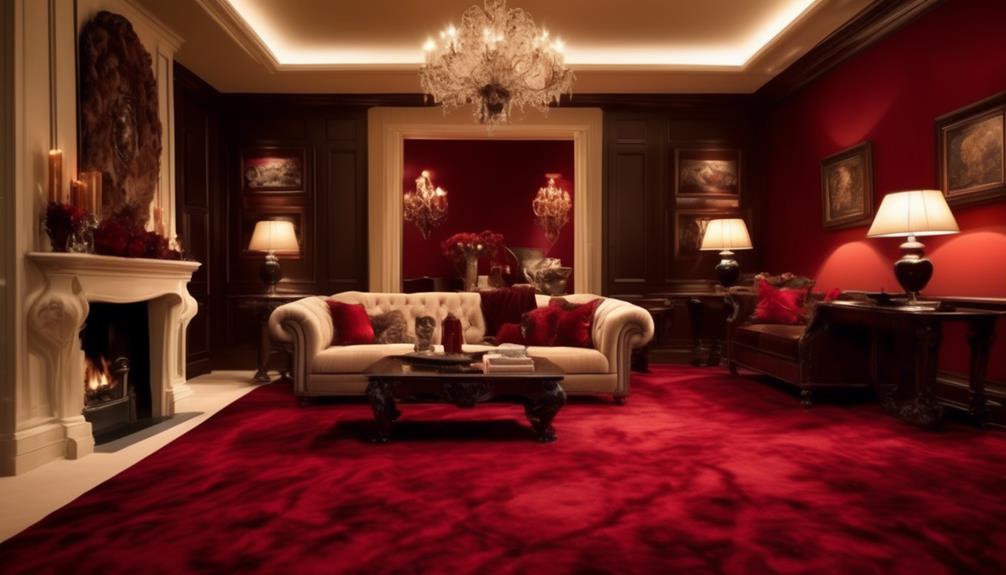
When it comes to carpet colors, we are frequently faced with the dilemma of balancing practicality and aesthetics. The color you choose for your carpet can significantly influence the overall ambiance and perception of a room. Whether you aim to create a warm, welcoming atmosphere or make a daring statement, the color of your carpet is essential in establishing the mood of your space.
But how do we navigate the myriad of options and make the best choice for our home? Join us as we explore the fascinating world of carpet colors, uncovering the psychology behind different hues and discovering the art of selecting the perfect color to enhance your living space.
Key Takeaways
- Different carpet colors can evoke specific emotions and moods in a room, such as warmth and energy with warm colors, or calmness and tranquility with cooler tones.
- Lighter shades of carpet can make a room feel more spacious, while darker colors add a sense of intimacy and coziness.
- Lighting, both natural and artificial, can greatly impact the perception of carpet colors and the overall mood in a room.
- Staying updated with color trends and incorporating personal style can help create a harmonious and stylish carpet selection that reflects contemporary styles and individual preferences.
Understanding the Psychology of Carpet Colors
As we explore the world of carpet colors, it's fascinating to delve into the psychology behind the hues that adorn our floors. Color associations play a significant role in how we perceive our living spaces. For instance, warm colors like reds and oranges can evoke feelings of energy and warmth, while cooler tones like blues and greens may impart a sense of calm and tranquility. These emotional impacts can influence our moods and behaviors, making it crucial to consider the psychological effects of carpet colors when designing interior spaces.
Cultural influences and personal preferences also play a pivotal role in the choice of carpet colors. Different cultures ascribe varying meanings to colors, which can influence the choices individuals make when selecting carpet hues. For instance, while white may symbolize purity and innocence in some cultures, it may signify mourning in others. Similarly, personal preferences based on individual experiences and associations with certain colors can heavily influence the selection of carpet colors for a particular space.
Understanding the psychological implications of carpet colors allows us to create harmonious and aesthetically pleasing environments that cater to our emotional needs and cultural inclinations.
Impact of Color on Room Perception

Exploring the impact of color on room perception reveals how the right hues can transform a space into an inviting and harmonious environment. Color perception plays a significant role in shaping the ambiance of a room, influencing emotions and behaviors.
Here are four key ways in which color impacts room perception:
- Emotion Elicitation: Colors have the power to evoke specific emotions, with warm tones like red and orange creating a cozy and energetic atmosphere, while cool tones like blue and green induce calmness and relaxation.
- Spatial Perception: Lighter shades can make a room feel more spacious and airy, while darker hues can add a sense of intimacy and coziness to larger spaces.
- Mood Enhancement: The right color choice can uplift and energize a room, enhancing the overall mood and creating a vibrant ambiance.
- Visual Harmony: By carefully selecting a color scheme, it's possible to achieve visual coherence and balance within a room, promoting a sense of unity and tranquility.
Understanding the intricate relationship between color and room perception enables us to craft spaces that not only look aesthetically pleasing but also feel emotionally enriching and harmonious.
Choosing the Best Carpet Color for Your Space
When it comes to choosing the best carpet color for our space, we can't overlook the impact of room size and lighting effects. The right color can make a small room feel more spacious, while lighting can drastically alter the appearance of the carpet.
We're about to uncover how these factors play a crucial role in selecting the perfect carpet color for any space.
Room Size
In selecting the ideal carpet color for your space, it's essential to consider the room size and how different hues can create an illusion of spaciousness or intimacy.
Lighter shades like soft blues and pale yellows can enhance spaciousness, making a room feel more open and airy.
Neutral tones such as beige, cream, or light grey can visually expand the room, especially when paired with minimalist furniture.
In a smaller space, consider using a monochromatic color scheme to create a seamless flow and make the room feel more expansive.
Darker colors like deep greens or rich browns can add a sense of intimacy and coziness to larger rooms, especially when complemented by warm lighting.
Understanding how carpet colors interact with room layout is crucial in achieving the desired visual expansion and ambience.
Lighting Effects
Consider the interplay of natural and artificial light as a key factor in determining the perfect carpet color for your space. Natural light can enhance the perception of color, while artificial lighting effects can alter the mood in a room. The color temperature of light sources influences how carpet colors appear, affecting their warmth or coolness. Additionally, color contrast is impacted by the interplay of light and can create visual interest in your space. Understanding these lighting effects is crucial for achieving the desired mood enhancement and color perception in your room.
| Natural Light | Artificial Lighting Effects |
|---|---|
| Enhances color perception | Alters mood in the room |
| Influences color temperature | Impacts warmth or coolness |
| Affects mood enhancement | Creates visual interest |
| Alters color contrast | Influences color perception |
| Impacts overall aesthetic | Influences overall aesthetic |
Utilizing Color Trends in Carpet Selection

As we explore the world of carpet colors, we're inspired by the dynamic interplay of color trends and interior design, guiding us to make stylish and modern carpet selections.
The utilization of color trends in carpet selection is an art form that can transform a space, creating a harmonious and visually appealing environment.
Here are four key points to consider when incorporating color trends in your carpet selection:
- Harmonizing with Interior Design: Utilize color trend forecasts to align carpet colors with the overall interior design scheme, creating a cohesive and unified space.
- Creating Room Ambiance: Incorporate color psychology principles to evoke specific emotions or moods within a room, such as tranquility with cool tones or energy with vibrant hues.
- Staying Updated with Trends: Stay abreast of current color trends to ensure that your carpet selection reflects contemporary styles and aesthetics.
- Adding Personal Touches: While following color trends is important, don't forget to infuse your personal style into the carpet selection, creating a space that feels uniquely yours.
Creating a Cozy Atmosphere With Carpet Colors
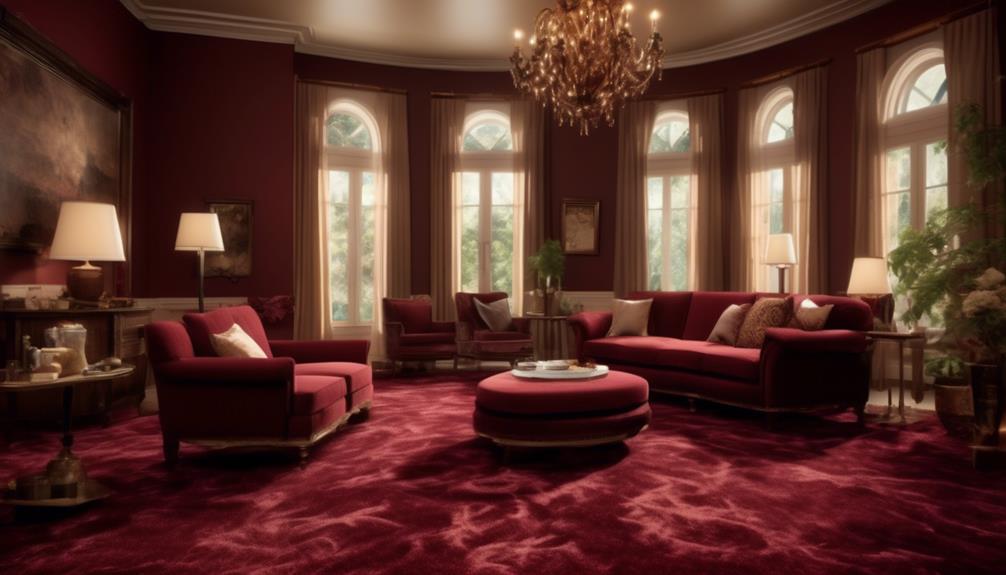
Embracing the warmth and comfort of plush carpet hues sets the stage for a cozy ambiance in any living space. When it comes to creating a snug and inviting atmosphere, the right carpet colors play a pivotal role.
To infuse a space with warmth, consider rich and earthy tones such as deep terracotta, warm chocolate browns, or soothing forest greens. These hues can evoke a sense of intimacy and comfort, transforming any room into a snug sanctuary. Pairing these warm hues with soft, tactile textures can further enhance the cozy decor, inviting you to sink your toes into sumptuous carpets that exude comfort.
When selecting carpet colors to create ambiance, consider the overall color palettes and the mood you wish to evoke. Soft neutrals like creamy ivory, pale greys, or sandy beige can also contribute to a tranquil and inviting ambiance.
Adding a Pop of Color to Your Space
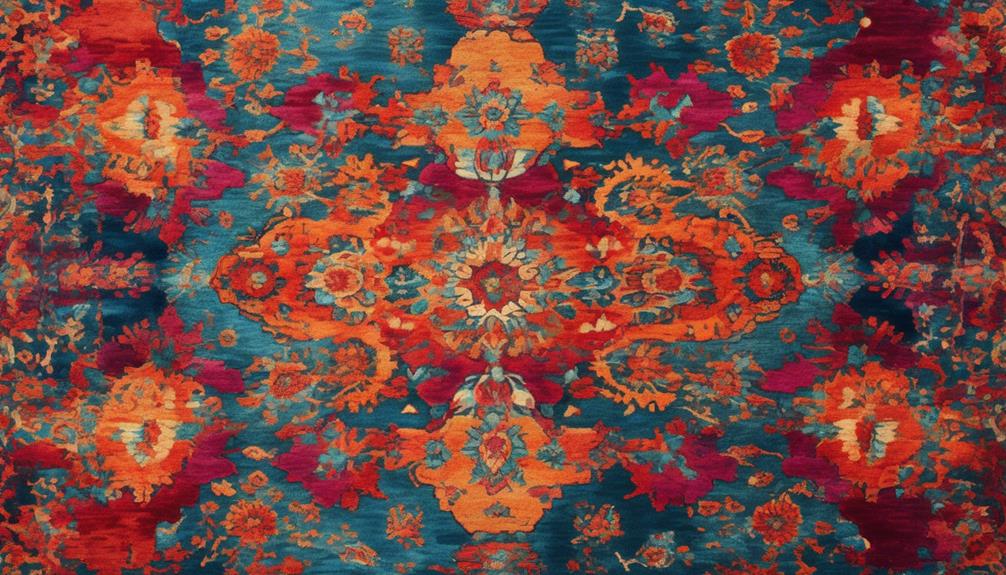
Let's talk about how a colorful rug can instantly transform a room and breathe new life into your space.
We'll explore the impact of bold hues and how they can create a vibrant focal point in any area.
Get ready to infuse your home with personality and style through the power of a pop of color!
Colorful Rug Selection
Selecting a colorful rug can instantly inject vibrancy and personality into your space, elevating the overall aesthetic and creating a focal point for the room. When choosing a colorful rug, consider the following:
- Color Psychology: Opt for bold colors like deep blues or rich oranges to evoke energy and creativity, or softer hues like pastel pinks and greens for a calming and tranquil atmosphere.
- Rug Patterns: Explore intricate geometric patterns for a modern and artistic touch, or opt for playful floral designs to add a whimsical and cheerful vibe to your space.
- Size and Placement: Ensure the rug is appropriately sized for the room and consider placing it in high-traffic areas to maximize its impact.
- Complementary Decor: Coordinate the rug with other elements in the room, such as pillows, throws, and artwork, to create a cohesive and harmonious look.
Impact of Bold Hues
Injecting a pop of bold hues into your space can elevate the overall aesthetic, creating a vibrant focal point that complements your colorful rug selection. Bold hues have a powerful visual impact, adding energy and personality to any room. Consider incorporating a statement piece in a striking color like emerald green, sapphire blue, or mustard yellow to create a captivating contrast against neutral tones. To showcase the impact of bold hues, here's a look at how different colors can transform a space:
| Color | Visual Impact | Example |
|---|---|---|
| Emerald | Bold and rich | Velvet emerald sofa |
| Sapphire | Elegant and regal | Sapphire accent chair |
| Mustard | Warm and inviting | Mustard throw pillows |
| Ruby | Dramatic and luxurious | Ruby area rug |
The Power of Neutral Carpet Tones
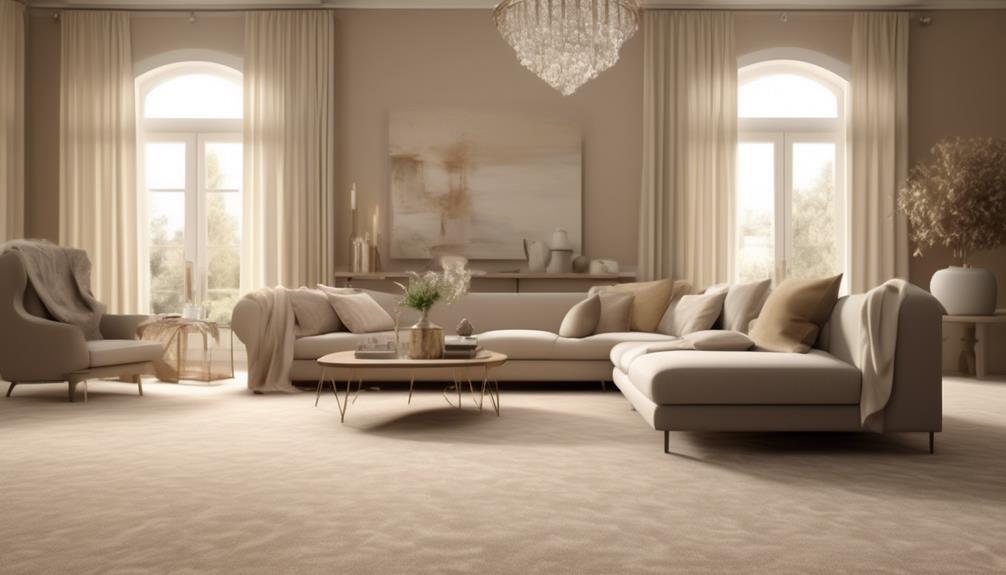
Neutral carpet tones exude a timeless elegance that effortlessly complements any interior design style. When it comes to choosing the right carpet color, the power of neutral tones can't be underestimated. Here's why they're a game-changer:
- Versatility: Neutral carpets provide a versatile foundation for any room, allowing you to experiment with various furniture styles and color schemes without clashing with the flooring.
- Timelessness: Unlike bold hues that may go in and out of trend, neutral tones have enduring appeal, ensuring that your interior remains stylish for years to come.
- Serenity: Neutral carpets create a calming and serene ambiance, perfect for creating a tranquil living space or a soothing bedroom retreat.
- Accentuation: With a neutral carpet, you can let your decor and furnishings take center stage, allowing you to play with textures, patterns, and statement pieces without overwhelming the space.
Incorporating neutral carpet tones into your interior design not only introduces a sense of balance and harmony but also provides a sophisticated backdrop for your personal style to shine.
Making a Bold Statement With Carpet Color
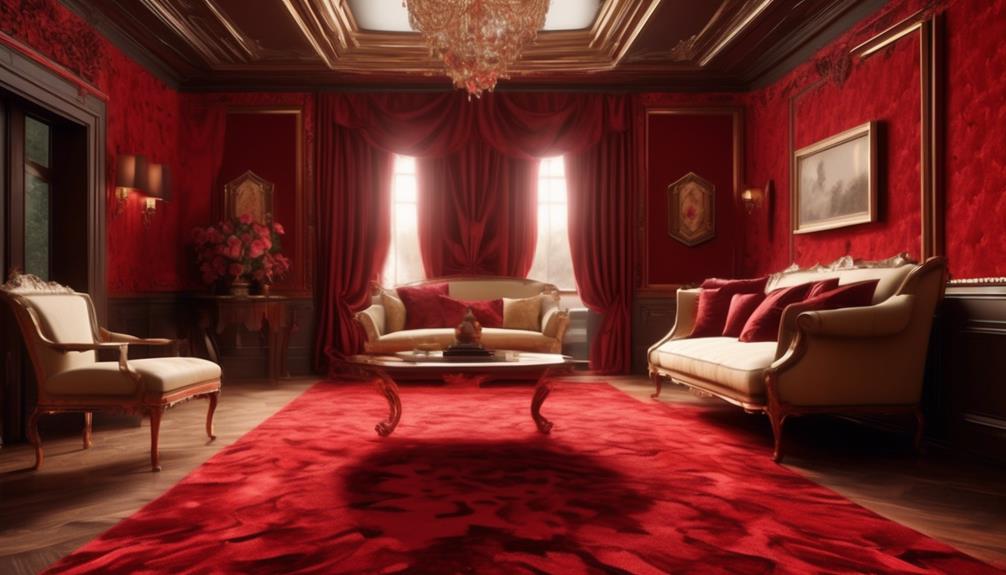
Let's talk about making a bold statement with carpet color. Impactful color choices can completely transform a space, elevating it from ordinary to extraordinary.
We'll also explore the fascinating world of color psychology in design, revealing how different hues can evoke specific emotions and moods.
Impactful Color Choices
Bold and vibrant carpet colors can transform a room, infusing it with energy and personality. When choosing impactful colors for your carpet, consider these key factors:
- Color Harmony: Opt for colors that complement the existing decor, creating a harmonious and cohesive look.
- Visual Impact: Select colors that make a statement and draw attention, adding an element of drama to the space.
- Personality Infusion: Choose colors that reflect your personal style and create a memorable impression.
- Room Functionality: Consider the purpose of the room when selecting bold colors, ensuring they enhance the overall atmosphere without overwhelming the space.
Color Psychology in Design
Infusing a room with energy and personality, vibrant carpet colors make an impactful statement, drawing attention and adding a touch of drama to the space. Color psychology plays a crucial role in design, as different hues evoke distinct emotions and moods. Understanding color symbolism and emotional impact is essential when selecting carpet colors for a space. Cultural influences also shape color perception, as certain shades may carry different meanings in various societies. By harnessing the power of color psychology, designers can create compelling interiors that resonate with the occupants on a deeper level. Here's a table that illustrates the emotional impact and cultural influences of specific carpet colors:
| Carpet Color | Emotional Impact | Cultural Influences |
|---|---|---|
| Red | Passion, Energy | Love, Luck |
| Blue | Calm, Serenity | Trust, Peace |
| Yellow | Happiness, Optimism | Joy, Vitality |
Using Carpet Color to Enhance Room Size
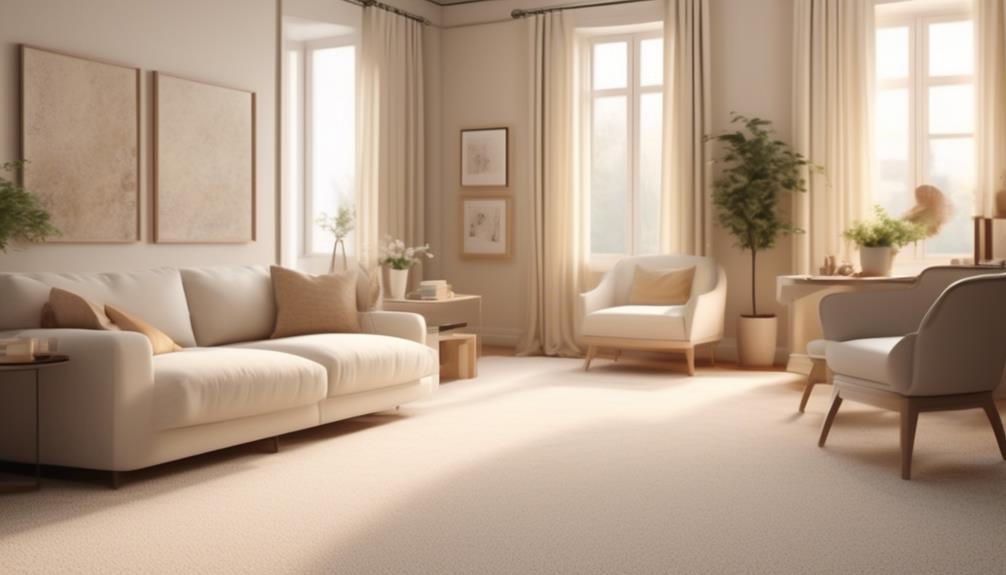
To create the illusion of a larger room, consider selecting a light-colored carpet that will reflect natural light and open up the space. Lighter hues create an airy and spacious feel, while darker tones tend to make a room appear more cozy and intimate.
Here are some tips to enhance room size with carpet color:
- Opt for light neutrals like cream, beige, or soft gray to make the room feel more expansive.
- Consider cool tones such as pale blue or mint green to evoke a sense of tranquility and openness.
- Use a monochromatic color scheme by matching the carpet color with the wall color to visually expand the space.
- Incorporate subtle patterns or textures in the carpet to add depth without overwhelming the room.
Achieving the Perfect Look for Your Home
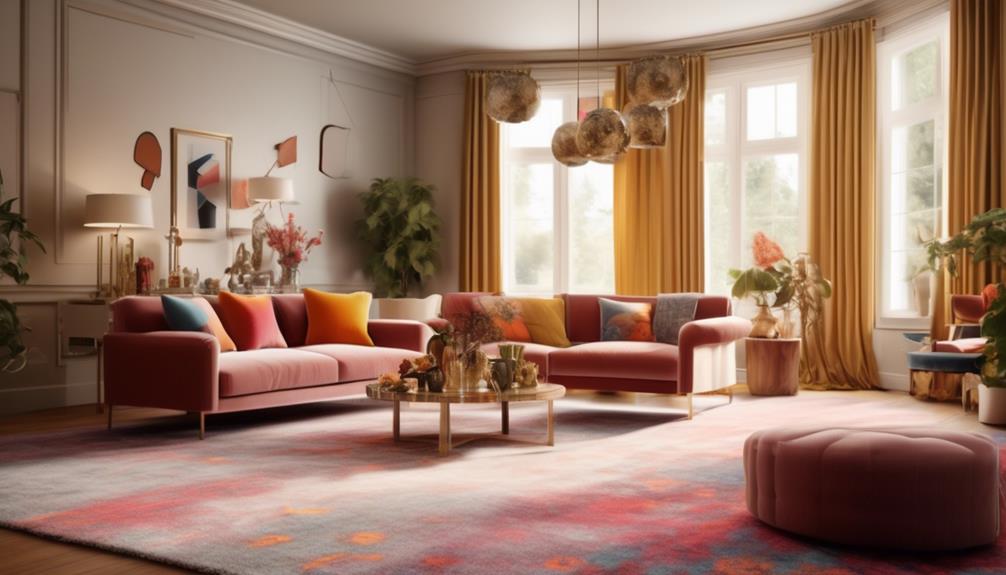
For our home to achieve the perfect look, we should carefully curate a harmonious blend of colors, textures, and decor elements that reflect our personal style and create a welcoming atmosphere. Color coordination is key to creating visual appeal and setting the right ambiance in every room. When selecting carpet colors, it's essential to consider how they complement the existing color scheme and furniture. To achieve a balanced and stylish look, we can incorporate a mix of neutral tones and bold accents. For instance, pairing a light grey carpet with vibrant accent pillows and artwork can create a modern and inviting living space. Additionally, integrating different textures such as a plush rug or a sleek hardwood floor can add depth and dimension to the room. To illustrate further, consider the following table that showcases a variety of color combinations for carpet and accent decor:
| Carpet Color | Accent Color 1 | Accent Color 2 | Accent Color 3 |
|---|---|---|---|
| Light Grey | Teal | Mustard Yellow | Charcoal |
| Beige | Navy Blue | Blush Pink | Gold |
| Dark Brown | Sage Green | Terracotta | Cream |
Frequently Asked Questions
What Are the Best Carpet Colors for Hiding Stains and Dirt?
We believe neutral tones are the best for hiding stains and dirt on carpets. They offer a perfect blend of practicality and style.
Neutral colors like beige, taupe, or light gray aren't only trendy but also provide a timeless aesthetic. Their versatility allows for easy coordination with different decor styles.
When it comes to carpet colors, choosing neutrals is a masterful choice for both functionality and elegance.
Can Carpet Color Affect the Temperature of a Room?
Absolutely, carpet color can have a significant impact on the temperature and mood of a room. Darker colors absorb more heat, potentially making the room feel warmer, while lighter colors reflect more light and heat, contributing to a cooler atmosphere.
This can also influence energy efficiency by affecting the need for heating and cooling.
Are There Any Cultural or Regional Considerations When Choosing Carpet Colors?
When considering carpet colors, cultural influences and regional preferences play a significant role.
Different cultures have unique color associations and symbolism, affecting their choices in interior design.
Regional preferences also influence carpet color choices due to climate, traditions, and local aesthetics.
Understanding these factors can help in creating spaces that resonate with a specific cultural or regional identity, adding depth and meaning to the design.
How Do Different Carpet Colors Impact the Acoustics of a Room?
When considering the impact of different carpet colors on acoustics, we've found that lighter colors can help create a sense of spaciousness, while darker hues absorb sound and enhance a cozy atmosphere.
This psychological impact can influence the overall experience of a room.
It's important to balance this with decorative options to achieve the desired aesthetic.
Understanding these dynamics allows us to masterfully design spaces that harmonize acoustics and visual appeal.
Can Carpet Color Affect the Resale Value of a Home?
Absolutely!
The color of the carpet can have a significant impact on the resale value of a home. Different carpet colors can have psychological effects on potential buyers and influence their preferences.
For instance, neutral tones like beige or gray are often preferred as they provide a versatile backdrop for various decor styles.
Bold or unconventional colors might limit the appeal of the space to potential buyers, potentially affecting the resale value.
Conclusion
So there you have it, folks! With the power of carpet colors, you can transform your space into a cozy nest or a bold statement piece.
Just remember, the right color can make a room feel larger, and the wrong color can make it feel like a cramped closet.
So choose wisely, and let your carpet color do the talking for your home!
- About the Author
- Latest Posts
Introducing Ron, the home decor aficionado at ByRetreat, whose passion for creating beautiful and inviting spaces is at the heart of his work. With his deep knowledge of home decor and his innate sense of style, Ron brings a wealth of expertise and a keen eye for detail to the ByRetreat team.
Ron’s love for home decor goes beyond aesthetics; he understands that our surroundings play a significant role in our overall well-being and productivity. With this in mind, Ron is dedicated to transforming remote workspaces into havens of comfort, functionality, and beauty.
-

 Vetted5 days ago
Vetted5 days ago15 Best Printers of 2024: Top Picks and Expert Reviews
-

 Vetted7 days ago
Vetted7 days ago15 Best Tile Sealers for Long-Lasting Protection and Shine
-

 Vetted2 weeks ago
Vetted2 weeks ago15 Best Smelling Floor Cleaners That Will Leave Your Home Fresh and Inviting
-

 Vetted1 week ago
Vetted1 week ago14 Best Power Scrubbers for Showers That Will Transform Your Cleaning Routine
-

 Vetted2 days ago
Vetted2 days ago15 Best LED Dimmer Switches With No Flicker: Ultimate Guide for a Flicker-Free Lighting Experience
-

 Vetted2 days ago
Vetted2 days ago15 Best Evergreen Plants for Shade Gardens: A Complete Guide
-

 Mardi Gras Decoration4 days ago
Mardi Gras Decoration4 days agoWhat Do the Symbols of Mardi Gras Mean?
-

 Appliances7 days ago
Appliances7 days ago5 Best Energy-Efficient Stainless Steel Fridges 2023





